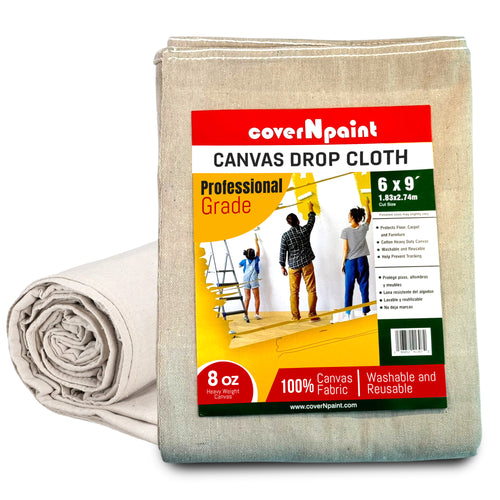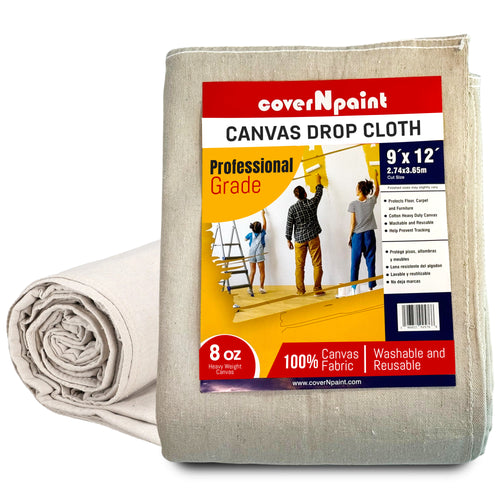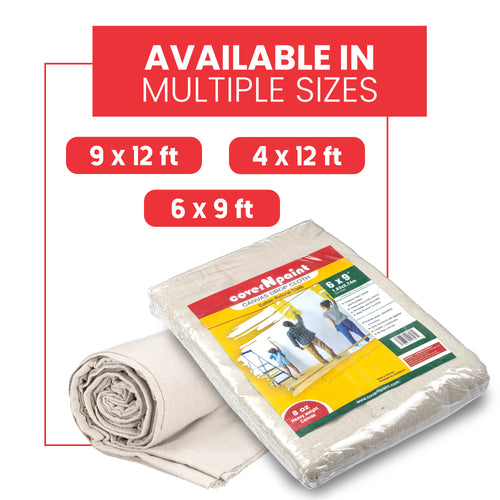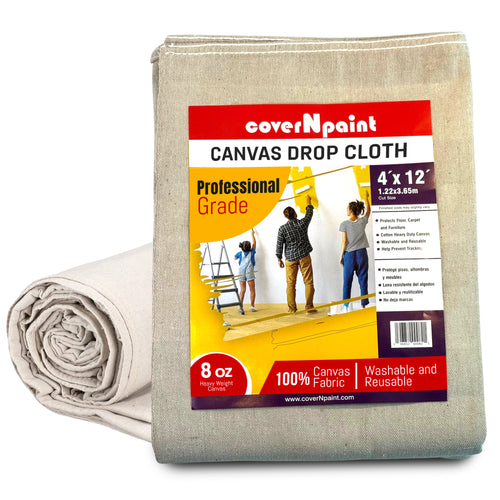When it comes to painting projects, whether at home or on a professional job site, one of the most overlooked tools is the paint tarp. Also known as a painters drop cloth or canvas drop cloth, this simple covering protects floors, furniture, and other surfaces from paint drips, spills, and stains.
While using a paint drop cloth seems straightforward, many people make mistakes that reduce its effectiveness, cause safety hazards, or even lead to more cleanup. This article highlights the top 7 mistakes to avoid when using paint tarps, ensuring your project stays clean, safe, and efficient.
1. Choosing The Wrong Material
Not all drop cloths are created equal. Using the wrong material is one of the most common mistakes.
-
Canvas Drop Cloths: Durable, reusable, and absorbent. Best for professional or long-term projects.
-
Plastic Tarps: Lightweight, waterproof, but slippery and prone to tearing. Good for quick, disposable use.
-
Paper/Poly Combinations: Affordable, but limited in durability and best for small jobs.
Mistake: Using thin plastic tarps for large-scale projects where durability is needed.
Solution: Invest in a canvas drop cloth for heavy-duty protection and long-term use.
2. Not Securing The Tarp Properly
A paint drop cloth that isn’t secured can shift, bunch up, or create tripping hazards. Many DIYers simply spread it out without taking time to anchor it.
Mistake: Leaving tarps loose on smooth floors like tiles or hardwood.
Solution: Use painter’s tape, weights, or non-slip pads to keep the tarp securely in place. For more on safety, review our detailed Painters Drop Cloth Safety Guide: Preventing Slips, Trips, and Falls.
3. Using The Wrong Size
A small tarp won’t provide enough coverage, while oversized tarps can be difficult to manage. Both create inefficiencies and potential hazards.
Mistake: Using a drop cloth that leaves gaps, exposing parts of the floor or furniture.
Solution: Measure the area before starting and choose a drop cloth size that covers your space comfortably. Keep multiple sizes on hand for flexibility.
4. Reusing Without Cleaning
Many people reuse painters drop cloths without cleaning them properly. Residual paint, dust, or debris can transfer onto new surfaces.
Mistake: Laying down a dirty canvas drop cloth from a previous project without washing it.
Solution: Shake off debris after each use, and wash canvas cloths on a gentle cycle with mild detergent. Allow them to dry completely before storage.
5. Ignoring Slip Hazards
Paint spills on a plastic paint drop cloth can make it extremely slippery. Even canvas, if not placed securely, can slide on smooth surfaces.
Mistake: Walking carelessly on a slick tarp or failing to notice pooled paint.
Solution: Place anti-slip mats under the cloth on slippery floors and always clean up spills immediately. Secure edges with tape for added safety.
6. Overlooking Storage Practices
Improper storage reduces the lifespan of your canvas drop cloths. Tossing them into a damp garage or folding them while still wet leads to mildew and damage.
Mistake: Storing drop cloths damp or crumpled in unsuitable spaces.
Solution: Always let the cloth dry completely. Fold or roll neatly and store in a dry, cool environment to preserve durability.
7. Assuming All Tarps Are Reusable
Not every paint tarp is built for multiple uses. Thin plastic sheets may be cheaper upfront, but they often tear after one project.
Mistake: Expecting a disposable plastic tarp to last as long as canvas.
Solution: For frequent projects, invest in a canvas drop cloth. For quick touch-ups, a disposable tarp is fine, but don’t confuse the two.
Expert Tips For Using Paint Tarps Effectively
-
Layer When Necessary: Combine canvas with plastic for messy or high-risk projects.
-
Keep Extras Ready: Have multiple tarps of different sizes available.
-
Train Your Team: If you’re managing a professional painting crew, make tarp safety part of the setup routine.
-
Think Sustainability: Reusable canvas drop cloths not only save money but also reduce environmental waste.
A Curiosity-Building Note
While avoiding these mistakes is key, there are also advanced techniques that can take your painting setup to the next level. Professionals know that even how you fold or layer a canvas drop cloth can significantly improve safety, efficiency, and results. coverNpaint USA continues to share such insider practices to help painters and DIYers make the most of their projects.
Benefits Of Avoiding Common Mistakes
-
Cleaner Projects: Surfaces remain protected from paint drips and splatters.
-
Longer Tarp Lifespan: Proper care extends the usability of canvas drop cloths.
-
Cost Savings: Reduces the need for frequent replacements.
-
Improved Safety: Prevents slips, trips, and falls.
-
Professional Results: Helps achieve a clean, polished finish.
FAQs
Q1: Are paint tarps and painters drop cloths the same?
Yes. A paint tarp is another term for a painter's drop cloth, typically made of canvas or plastic.
Q2: How do I clean a canvas drop cloth?
The machine washes on a gentle cycle with cold water and mild detergent. Avoid bleach and dry completely before storing.
Q3: Can I reuse plastic paint tarps?
Some heavy-duty plastic tarps can be reused, but most are designed for one-time use. For durability, choose canvas.
Q4: What’s the safest way to secure a paint drop cloth?
Use painter’s tape on edges, add non-slip mats underneath, or place weights in the corners to prevent shifting.
Q5: Do I need different sizes of drop cloths?
Yes. Small cloths are ideal for furniture, while large canvas drop cloths work best for room-wide floor protection.












